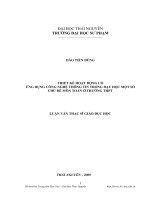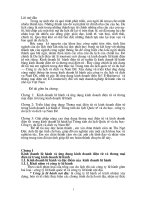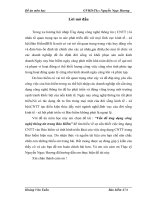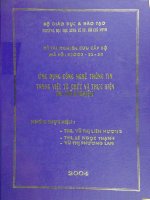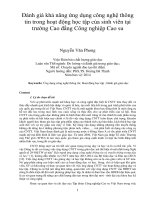Ứng dụng công nghệ thông tin trong đề án học tập để dạy kĩ năng nói học sinh trường THPT lê hồng phong
Bạn đang xem bản rút gọn của tài liệu. Xem và tải ngay bản đầy đủ của tài liệu tại đây (681.19 KB, 130 trang )
THAI NGUYEN UNIVERSITY
SCHOOL OF FOREIGN LANGUAGES
TRAN THI BINH
APPLYING INFORMATION TECHNOLOGY IN TEACHING
SPEAKING SKILLS FOR STUDENTS AT LE HONG PHONG
HIGH SCHOOL via PBL
(Ứng dụng công nghệ thông tin trong đề án học tập để dạy kĩ năng nói học sinh
trường THPT Lê Hồng Phong)
M.A THESIS
Field: English Linguistics
Code: 8220202
THAI NGUYEN – 2018
Acknowledgement
In completion of my thesis, I have received generous advice and help from many
lecturers whose lectures are very practical and useful. Firstly, I would like to express
my sincere thanks to my supervisors Dr. Hoang Thi Ngoc Diem and Dr. Nguyen Thi
Minh Loan from School of Foreign Languages, Thai Nguyen University for her
close guidance, criticism, and her generous help in the process of completing my thesis.
My special thanks also go to all lecturers and the staff of the Schools of Foreign
Languages for their useful materials, guidance and enthusiasm during my course of
study.
I really wish to thank all my colleagues and my students at Le Hong Phong High
school for their kind cooperation in giving valuable information.
Finally, I owe my deep thanks to my dear family, specially my husband, my
little children and my friends who always stand for me with their consideration and
encouragement.
Abstract
This research was conducted to the eleventh grade students and EFL teachers of
Le Hong Phong high school, Pho Yen Town, Thai Nguyen province in academic year
2017-2018. The aim of this research was to find out how well the use of Project-based
learning with the help of m-learning in improving students’ speaking skill, the trend in
ICT use of the EFL teachers and attitude and motivation in learning foreign language.
In conducting this research, the writer designed an experimental study that pursues to
boost the students’ speaking competences. Before drawing the experiment, ten EFL
teachers and both groups were carried out questionnaires to measure both the teachers’
trend in use of ICT and attitude and motivation towards learning English. The findings
of this research showed that there was an improvement on students’ speaking skill
through project-based learning with Aurasma app particularly in accuracy and fluency.
The results of this study suggest that the EFL teachers seemed to be aware of
the benefits of ICT to their classroom instruction of the English language. They also
indicated that their beliefs about ICT benefits had the biggest impact on their ICT use.
Moreover, the EFL students’ English language competence improved significantly in
almost all area of their speaking competence after the implementation of the PBL
lesson plan with the help of m-learning. The control group only showed
improvements in grammar and vocabulary because their curriculum focused mainly on
those areas. The experimental group showed positive changes in their attitudes and
motivation towards learning English after the PBL lesson plan, while control group’s
attitudes and motivation remained unchanged.
The importance of having competence in English is well-recognized. However,
high school students’ speaking level entails not only the speaking competence but
competency in reading, writing and listening as well. Therefore, future studies should
explore effectiveness of PBL in developing students’ reading, writing and listening
skills with the help of m-learning.
TABLE OF CONTENTS
Chapter 1: INTRODUCTION ...............................................................................................................1
1.1. Rationale for the study.................................................................................................................1
1.2. Aims of the study ..........................................................................................................................4
1.3. Significance of the paper .............................................................................................................4
1.4. Scope of the study.........................................................................................................................5
1.5. Organization .................................................................................................................................5
CHAPTER 2: LITERATURE REVIEW ..............................................................................................6
2.1. Research context ..........................................................................................................................6
2.1.1. Influence of traditional pedagogy on language education .................................................6
2.1.2. Role of teachers .....................................................................................................................6
2.1.3. Roles of examinations ...........................................................................................................7
2.1.4. Roles of textbooks..................................................................................................................8
2.1.5. Students in classroom ...........................................................................................................8
2.2. Communicative Language Teaching (CLT) ..............................................................................8
2.2.1. Traditional language teaching methods ..............................................................................9
2.2.2. Communicative Language Teaching in the current school system ............................... 10
2.3. English speaking skill................................................................................................................ 14
2.3.1. Speaking skill ...................................................................................................................... 14
2.3.2. Speaking Competence ........................................................................................................ 16
2.3.3. Speaking sub- competence................................................................................................. 16
2.3.4. The importance of acquiring speaking skill..................................................................... 18
2.3.5. Ways of developing speaking skill .................................................................................... 19
2.3.6. Characteristics of a successful English speaking classroom........................................... 20
2.4. Project Based Learning (PBL) ................................................................................................. 21
2.4.1. Definition of PBL................................................................................................................ 21
2.4.2. Benefits of PBL in English speaking classroom............................................................... 23
2.5. Mobile technology to support speaking skill........................................................................... 26
2.5.1. Augmented Reality (AR) ................................................................................................... 26
2.5.2. Aurasma .............................................................................................................................. 27
2.5.3. Previous studies .................................................................................................................. 28
CHAPTER 3: RESEARCH METHODOLOGY............................................................................... 31
3.1. Research design ......................................................................................................................... 32
3.2. Participants................................................................................................................................ 32
3.3. Data collection instruments ...................................................................................................... 33
3.3.1. Survey questionnaire ......................................................................................................... 33
3.3.2. Pre-test and post-test.......................................................................................................... 33
3.4. Data collection procedure ......................................................................................................... 34
3.5.1. Survey analysis ................................................................................................................... 37
3.5.2. Pre-test and post-test analysis ........................................................................................... 38
CHAPTER 4: RESULTS AND DISCUSSION.................................................................................. 40
4.1. Results ........................................................................................................................................ 40
4.1.1. ICT applications ................................................................................................................. 40
4.1.2 Pre-test result....................................................................................................................... 42
4.1.3. Post-test result .................................................................................................................... 44
4.1.4. Pre-test and post-test comparison..................................................................................... 46
4.1.5. Results after using PBL with m-learning ......................................................................... 46
4.1.6. Comparisons of attitudes and motivation levels .............................................................. 47
4.1.7.Attitudes and motivation in the experimental group after the treatment...................... 47
4.2 Discussion.................................................................................................................................... 47
4.2.1. ICT applications ................................................................................................................. 47
4.2.2. The same level speaking competence of the control and experimental groups ........... 48
4.2.3. Improvement after implementing the PBL lesson plan .................................................. 49
4.2.4. Progress on attitudes and motivation after the intervention.......................................... 50
CHAPTER 5: IMPLICATIONS AND CONCLUSION ................................................................... 53
5.1. Implications ............................................................................................................................... 53
5.2. Limitation and suggestion for further research ..................................................................... 54
5.3. Conclusion.................................................................................................................................. 54
References
Appendixes
List of tables
Table 1
Frequency of Use of ICT
Page 40
List of Figures
Figure 1 The mean pre-test scores of overall speaking competences
Page 41
and sub-competences of control group and experimental
group
Figure 2 The mean post-test score of the control group and experimental
group in overall speaking and sub-competences
Page
43
List of abbreviations
AR
Augmented Reality
EFL
English as a Foreign Language
CLT
Communication Language Teaching
ICT
Information and Communication Technology
IT
Information Technology
m-learning Mobile- learning
MoET
Ministry of Education and Training
PBL
Project- Based Learning
Chapter 1: INTRODUCTION
1.1. Rationale for the study
English is one of the most common languages in the world, and the most
popular second language of study in Vietnam (Crystal, 2012). A chain of economic
reforms in
1986 and 1993 have been creating a flow in the number of people learning English (Tri,
2001). Following Vietnam becoming a member of the Association of Southeast Asian
Nations (ASEAN) in 1995 and the World Trade Organization (WTO) in 2006, many
foreigners and investors launched business in Vietnam. Vietnam has seen rapidly
economic development and an explosion in commercial cooperation, technology
advancement and culture exchanges with other part of the world. This has given a rise
to a pressing demand for English proficiency (Le, 2005).
The recent development in the country, together with increased globalisation,
has created more career opportunities for the Vietnamese people. Needless to say the
needs of Vietnamese people to use English in their work and daily lives have been
dramatically increasing. Therefore, teaching and learning English have a vital role in
raising the English competence. However, Vietnamese students especially in the
schools in rural areas have difficulties in learning and practising speaking skill because
of limited access to authentic materials, out of date teaching methods and over- sized
classes with multi- level. Consequently, the so- called “deaf and dumb English” users
are ironically referred to many learner generations with in complete English
competence. (Hoang, 2015).
Another reason for the inconsistencies between the numbers of the expected and
actual fluent English speakers in the country might be due to the teacher- centred
model of teaching and the ways that Vietnamese students study and are evaluated. In
this model, the focus is on the teacher only, while the students sit quietly and listen as
the teacher instructs the whole class. The teacher’s responsibility is observed as being
the contents delivery, where as the students’ role is swallowing the content (Pratt et
1
al.1999). Furthermore, Vietnamese students believe that learning is memorizing books
or information provided by teachers in class (Kennedy, 2002). The teacher is usually
the
1
sole source of verbal English input for the students. Thus, the students normally do not
participate in classroom activities, are unwilling to give answers or ask questions and
are reliant on the teacher (Braddock et al., 1995). The teacher- centred model results in
a passive learning style on the almost part of the students, and a situation where the
students are uncomfortably speaking English outside the classroom.
In addition, the education system and examinations focus almost entirely on
grammar and vocabulary (Peterson, 2014). Since Vietnamese students study English to
pass the examinations and to move to further study (Denham,1992), they tend to
overlook the verbal communication parts such as pronunciation, speaking and listening.
The grammar and vocabulary-heavy curriculum and examinations means that the
students rarely have chances to practice communicating with each other in English in
the classroom.
According to Kayi (2006), foreign language teachers should pay much attention
to teaching speaking because “the ability to communicate in a foreign language clearly
and efficiently contributes to success of the learners in school and success later in every
phase of life”. Instead of leading students to purely learn by memorization, English
teachers should provide a rich environment for the students, where meaningful
communication can take place.
The term to denote one’s competency in speaking a language is named speaking
competence. Speaking competence is one’s skills, knowledge, and motivation to speak
to anyone in any context. To develop these speaking competences, it is essential to
teach and encourage verbal communication.
To improve speaking competences of students in English, and to increase their
experience of speaking the language, this paper uses a well-established methodology,
known as Communicative Language Teaching (CLT). CLT is “a set of principles about
the goals of language teaching, how learners learn a language, the kinds of classroom
activities that best facilitate learning, and the roles of teachers and learners in
2
classroom” (Richard, 2006). The purpose of the communicative approach is to
communicative with
2
other people in a classroom and later in a society. Among the CLT method, Project
Based Learning (PBL) is the one that has received much attention and is seen as the
effective in improving speaking competence (Barron et al, 1998; Markham, 2011).
Obviously, Project Based Learning (PBL) has been consider as a powerful
approach in content instruction and it was adapted into other disciplines. Two decades
ago, PBL has been incorporating into language classroom (Di & Nattaya, 2016). “PBL
can help a teacher create a high- performing classroom in which the teacher and
students form a
powerful learning community focused on
achievement, self-
mastery, and contribution to the community” (Barron et al, 1998; Markham, 2011).
Moreover, in recent times, ICT applications from Learning Management System
to Web 4.0 technologies have increasingly been applied in education, so that ICT is
seen as the means to support innovative teaching and learning (Peeaer and Petegem,
2001). In spite of that, the role of technology in teaching and learning is not received
much attention in high schools, especially ones in mountainous areas.
The major obstacles to achieve English speaking competency is the method used
in teaching and testing. Most students learn English to pass the national examinations
in which listening and speaking English are not components. To pass the national
grammar- based and norm- referenced examination requires the students to have a
sufficiently good knowledge of the grammar and vocabulary of the target language,
thus communicative needs are not their obvious motivation (Canh,2001). Even
under a
new
national education program, many teachers continue to apply the
traditional grammar- translation method, which focuses on reading and writing. The
Ministry of Education and Training’s curriculum is also exam-based, meaning it tests
grammar, reading and translation, all of which can be easily done on written exams.
However, how to meet both the aims of the Project 2020 and the aims of the National
Examination is a big question. There are few researches on the benefits of applying
PBL with m-learning in teaching speaking for high school students. Therefore, it is
3
necessary to carry out study to make suitable revision and suggestion to meet the need
of the learning and teaching requirement.
4
With all the reasons mentioned above, this study aim to explore whether or not
PBL combining ICT can develop the speaking competence of students.
1.2. Aims of the study
Given the aim above, the research set for itself the following objectives:
1. To evaluate the current situation of using technology in teaching and learning
at Le Hong Phong high school
2. To investigate the effect of a specific mobile application for PBL among
students at Le Hong Phong High school
3. To explore the attitudes of the teachers and students towards the adoption of
m-learning in PBL.
To achieve the aims of the study, the following research questions are found.
1. What is the current situation of using technology in teaching and learning at
high school?
2. What are the effects of mobile applications in learning English via PBL at Le
Hong Phong High school?
3. What are the attitudes of the teachers and students towards the adoption of
m- learning in PBL?
1.3. Significance of the study
As a first attempt to look at the effects of implementing a mobile application for
PBL in teaching speaking at high school, this study would be beneficial not only to
teachers and students at high school but also to education administrators.
Through an investigating the effect of a specific mobile application for PBL among
students at Le Hong Phong High school and exploring the attitudes of the teachers and
students towards the adoption of m-learning in PBL, the research would be both
theoretical and practical values. In the theoretical perspective, with the hope of marking
a small contribution to English Language Teaching especially teaching speaking skill.
With the investigation of the current situations, the research would be of practical value
in teaching practice. For many teachers, PBL with technology can help them create a
4
high- performing classroom in which the teachers and students form a powerful
learning community. The research is a chance for high school teachers to raise their
voices about what they are facing every day. As a result, the understanding the
situations is a source of reference for the curriculum designers, textbook writers and
education officials.
1.4. Scope of the study
Founded in 1951, Le Hong Phong high school is located in the centre of Pho
Yen town, whose population are mainly peasants. The students mostly living in rural
and mountainous areas have a difficulties in learning and practicing speaking skill
because of limited access to authentic materials, out of date teaching methods and
over- sized classes with multi- level. Now, there have been 45 classes with 1968
students and 110 teachers in the school. Among 14 English teachers in the school, there
are only 5 of them graduated from English formal university. None of the teachers get
Masters degree. The school’s mission is to provide education for children in nine
communes in Pho Yen.
On the account of beneficial impacts of PBL combining mobile technologies in
learning and its infant development in EFL education in Vietnam, the researcher would
like to conduct a research to examine the effectiveness of mobile technologies and PBL
in EFL performance. Due to the broad spectrum of the research interest, the author
would like to narrow the scope of the study to PBL with augmented reality mobile
applications and English speaking skills in the pilot experiment.
1.5. Organization
This study is going to be organized around five parts:
Chapter 1: Introduction- presents rationale for the study, context of the study,
aim of the study, objectives of the study, research questions, significance of the study,
scope of the study and organization of the study.
Chapter 2- Literature Review- reviews theoretical issues related to speaking
competence, PBL and technology.
5
Chapter 3- Methodology- describes research context, explains the reasons for the
research method choice and how data collection and analysis will be set up.
Chapter 4- Results and discussions- presents main findings of effects of PBL
with technology on teaching speaking and teachers and students’ attitudes according to
the themes. Interprets and discussed data according to research questions stated at the
beginning of the study.
Chapter 5- Conclusions and Implications- recapitulates what has been
investigated, draws conclusions from major findings, points out limitations of the
study, and makes some suggestions for further research. Special recommendations are
made on what should be done to increase the quality of teaching and learning speaking
skill at high school.
CHAPTER 2: LITERATURE REVIEW
2.1. Research context
2.1.1. Influence of traditional pedagogy on language education
The development of English Language Teaching in Vietnam has been affected
by traditional pedagogy. This section describes how important elements in the
curriculum, that is, the teacher, examination and textbook, traditionally exert their
influences on pedagogy, which is also affected by long lasting ideologies. Vietnam was
under the domination of China for almost a thousand years, so it is clear that the
impacts of Chinese ideologies, especially Confucianism, on Vietnam society and
education were unavoidable ( Ellis 1994; London 2001; Rao, 2002). The teachers ,
teaching methodology, learning environments, textbooks and assessment are reviewed
to consider their impact on current English Language Teaching.
2.1.2. Role of teachers
The teacher plays a central role in traditional in Vietnam: “ the tradition that the
teacher is honoured and respected” (Kramsch&Sullivan, 1996, p.206). The important
role of the teacher is nowadays is felt in the following saying:
6
“ Không thầy đố mày làm nên”
Respect for teachers is respected that a teacher in Vietnam is considered to be an
all- knowing “ fount of knowledge” (Littlewood, 2000, p34) and a moral role model
(Phan 2004).He or she is a wise person who has knowledge; their knowledge is like a
full bucket of water, while what they give students only amounts to a bowl of water
(Pham, 2008). Teachers are considered role models of “good moral quality, ethically
and ideologically” (Nguyen et al., 2006, p.5) that students should follow.
Respect for teachers is also illustrated by the reality that students are socialised
to value “the absolute authority” of the teacher. Knowledge is transmitted by the
teachers and students act as receivers (Nguyen, 2011;Nguyen, 2011; Le, 2004).
Students are not encouraged to think independently. What the teacher says is always
correct and cannot be challenged. Communication between teachers and students is
generally one way because arguing and discussing with teachers, parents or elders is
often considered as rude and disrespectful ( Nguyen, 2001).
2.1.3. Roles of examinations
Examinations have had an important role to play in Vietnam. In the past,
“success in the test meant that one was a member of a pool of scholars” (Sullivan,
1996, p27). It was also believed that when students succeeded in examinations, they
could bring honour to their families. This is to say, educational achievements are
essentially important for not only students but also the communities around them.
Nowadays, Vietnamese parents, children and society as a whole still hold the believe
that success in examinations is a “ticket to ride” towards a better life and upward social
mobility (Le, 2011). Consequently, parents encourage and support the children in their
schooling while the students try as hard as they can to achieve a high a level as possible
in the educational system, especially to gain a place at the university, which is highly
competitive (Tran et al., 2010). Thousands of high school leavers sit for the National
University Entrance Examination annually, but only about 10 percent are admitted.
This
7
emphasises the importance of examinations in the current society (Le, 2001) unless
students do well in them, they are unlikely to progress their studies.
2.1.4. Roles of textbooks
The curriculum in Vietnam is based on prescribed textbooks. In fact, the
textbook “becomes the curriculum” and “ instruction is largely, if not completely
textbook- driven” (Le, 2011,p.19).
Vietnamese students are accustomed to traditional pedagogy. Specifically, they
engage in learning which involves following the text to the letter and memorising the
knowledge gain from the texts (Latchem & Ryan, 2013). It is because of such heavily
textbook- dependent practices that anything not included in the textbook is not
perceived as “learning” for Vietnamese students. This also reflects the fact that ELT
pedagogy in Vietnam has typically focused on grammatical rules and vocabulary
which students memorise from textbooks, and neglected communicative skills like
speaking or writing.
2.1.5. Students in classroom
Researchers on Vietnamese students’ preferences have indicated that the context
of teaching and learning in Vietnam leads students to consider classmates as “families”.
Kramsch and Sullivan (1996) observed in Vietnam, students are placed into
classes of approximately thirty to fifty when they enter the university. Members of
these classes often live, study, and play together. The associations students form are
more related to Western notions of “family” than “classmate”. In many cases students
in the same class will continue close relationships throughout their lives, forming ideas
that encompass financial, familial, and social obligations. (p203)
2.2. Communicative Language Teaching (CLT)
Due to the importance of the English language today, and the demand for
qualified teachers, a good command of English is necessary to satisfied the market
demands. In the 1960s, English was taught using grammar-based, translation-based
methods. By the 1970s a new approach was introduced, focusing on what the
8
traditional approach lacked most, which is speaking the language proficiently. The new
approach,
9
known as Communicative Language Teaching, aims to teach language for the purposes
of communication. However, compared with the traditional methods, the advantages
and disadvantages will be discussed in order to see why CLT is essential for
developing the students’ communicative abilities, especially in speaking skill.
2.2.1. Traditional language teaching methods
The “traditional language teaching approach” is an umbrella term for language
teaching methods developed before the 1970s. The most commonly used methods were
grammar-translation, direct and audio-lingual methods. Those methods were used for
the most 19th century to teach modern foreign languages (Richards and Rodgers,
2001).
As early as the seventeenth century, the grammar-translation method was the
way languages were taught in schools. This approach focuses on analysing and
studying the grammatical rules of a language by translating to and from one’s mother
tongue and the target language. Using grammar and vocabulary accurately is central to
the grammar- translation approach (Larsen-Freeman and Anderson, 2011).
The grammar-translation method is an academic exercise, using grammar to
learn the target language, rather than an exercise to assist the learners in using the
language (Cook, 2013). The teachers give instructions, explain conceptual problems
and discuss the particular grammatical structure in the mother tongue. The teacher
typically present the rules of one grammatical instance and the
illustrate its use
through repetition in reading, writing and
text
translating. The
is
often
accompanied by a list of new vocabulary. In the grammar-translation method,
repetition are essential to learn, not students themselves.
As unimaginative as it sounds, however, the grammar-translation method has
achieved remarkable success. Wahba, Taha and England (2013) observed that millions
of people had successfully learned a second language to a high degree of proficiency
using the grammar- translation method. However, students could be more involved in
the coursework instead of simply following the textbook and making corrections
10
afterward. Therefore, the direct method was created as a consequence to the grammartranslation method (Hinkel, 2011).
The direct method focuses on the written language, where grammar and
vocabulary are taught inductively by means of direct translations. Rather than
analysing and explaining grammar rules, students are encouraged to communicate
freely and use grammar naturally.
In this approach, all teaching is done using the target language. The teachers
may employ visual aids to clarify concepts and vocabulary. The learners speak in the
target language and speak as if they are in real life. Since all teaching is performed in
the target language, this approach is often referred to as the natural or oral method
(Wahba, Taha, and England, 2013).
2.2.2. Communicative Language Teaching in the current school system
Currently, teaching English as a second/ foreign language is emphasised in
curriculum at all levels in the educational system in Vietnam. The formal education
school system in Vietnam is divided into five levels: primary education from grade 1 to
grade 5, lower secondary education from grade 6 to grade 9, upper secondary education
from grade 10 to grade 12, undergraduate education and postgraduate education.
Primary education starts when children are age six. In some larger cities, English is an
optional subject taught to students from grade 3 to grade 5, and it is a compulsory
subject in all other upper levels.
In the early 1990s, English language teaching practices in Vietnam, reflected the
dominance of the grammar-translation method (Denham, 1992).The focus of teaching
was on developing students’ reading skills. The class size was, on average of 50
students. Teachers had a relatively poor command of spoken English. There were
limited opportunities for English learners to communicate with native English
speakers. Since
11
2002, the high school English language curriculum has undergone a process of
renewal. The aims of this are to move towards a more communicative approach (Tran,
2009; Le, and Barnard, 2009).
12
A communicative language teaching (CLT) approach emphasises the use of
language to communicate. This approach is based on the beliefs, that given the right
conditions, “language learning will take care of itself” (Harmer, 2007, p.52) and
“language is learnt through meaningful language use” (Klapper, 2003,p. 52). The main
function of a language is to communicate; therefore, we can learn language by
exposure to it and using it to communicate authentically. Learning activities in CLT are
designed to “engage learners in meaningful and authentic language use” (Richards &
Rogers,
2001, p. 72). For example, if learners are learning about how to shop in a supermarket,
they will be taken to “real” supermarkets to be served as customers. In short, the focus
of CLT is learners’ using English in realistic contexts (Butler, 2011; Richards &
Rogers,
2001; Savignon, 2007).
Since CLT’s introduction, both its strong and weak versions have been theorised
(Butler, 2011; Klapper, 2003; Littlewood, 2007; Richards & Rogers, 2001). In strong
CLT, an authentic context for learners to communicate is important. By exposure to
such a context, learners are able to actively frame language use themselves.
Knowledge is gained through the social negotiation between teachers and learners: the
teacher’s role is to provide learners with authentic communicative activities. By
contrast, the week version of CLT teachers’ involvement in the learning process
through their provision of language structures. Language accuracy and fluency are
equally important.
Like many Asian countries where CLT has become the dominant approach in
ETF (Butler, 2011; Kam, 2006; Littlewood, 2007)., Vietnam has advocated CLT
through policy. This observed through the high school curriculum renewal in 2000 as
discussed above, and this has clearly been documented in the MoET’s recent policies
(1400/QD- TTG, 2008; MoET, 2006, 2014). For example, for secondary education the
MoET requires that “communicative skills are the goal of the teaching of English at
11
the secondary school while formal knowledge of the language serves as the meet to the
end” (MoET, 2006), p.6 translated by Barnard and Nguyen (2010). In the most recent
policy, the government issued Decision 1400/QD-TTG (2008) to implement the
Vietnam’s
12
